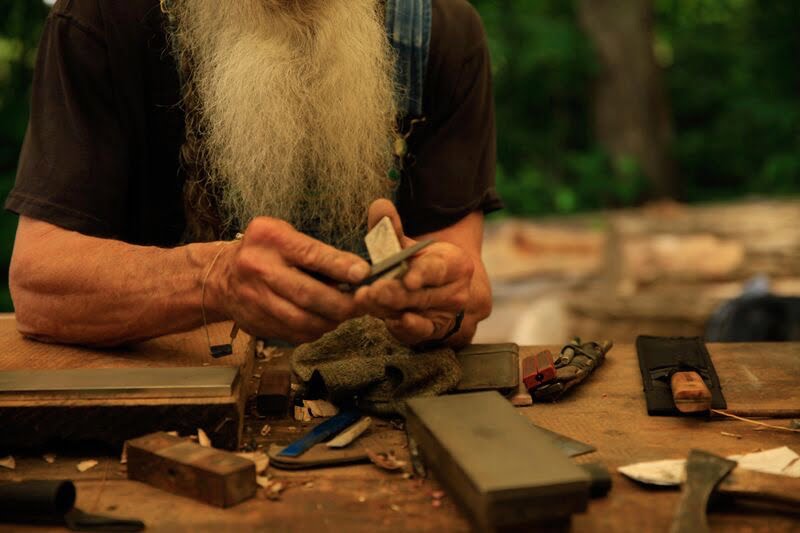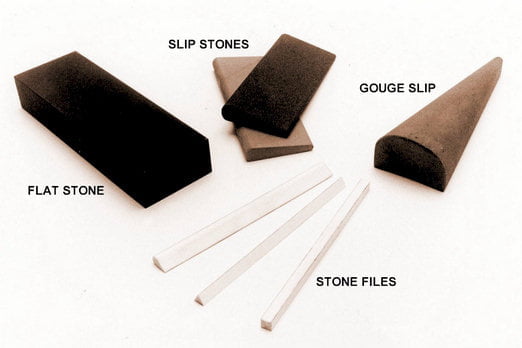Our tools do so much work for us. The right tool for the job, in good working order, can turn hard work into a pleasure. Conversely, using the wrong tool, or one that is out of shape, can turn a simple task into a struggle. Taking time to care for your tools may feel like a luxury in a busy world, but you will be glad you did! Ultimately maintaining your tools will save your time, keep you safe, and bring ease to your work.
Whether you’re skinning and processing a deer, working in the garden, harvesting wild mushrooms, cutting firewood, building a tiny house, or just cooking dinner, sharp tools will help you work happily and successfully.
How to Sharpen Tools

Everyone knows that it’s important to keep knives and axes good and sharp, but many other tools also benefit from, and work better with, a finely honed edge. No matter what you are sharpening, be sure to clean the blade first. Grinding dirt and grit into metal is never a good idea. It’s also smart to sharpen tools in an area with good light so that you can see what you are doing.
One great tip for beginner tool-sharpeners is to use a marker to black out all along the edge that you will be honing. You will be able to see how evenly you are working by looking at where the ink is being removed as you sharpen. For blades with beveled edges, you need only sharpen the beveled side. After that, give a few gentle passes to the other side to remove the burr of metal that arises from sharpening. Removing the burr is an important final step even if you are sharpening both sides of a blade.
To learn about all of our favorite gardening tools, join us for the Online Gardening School.
Tools for Sharpening Tools
It’s handy to have several different sharpening devices (tools to sharpen your tools!) so you can use the appropriate one for each job. A good whetstone is indispensable for straight-bladed cutting tools (knives, hatchets, pruners, loppers, even scissors). Having a set of three stones (coarse, regular and fine) is even better. Both natural and synthetic stones are available. Small, wallet-sized diamond stones are very convenient and usually affordable.


Curved blades, such as scythes, sickles, gouges, bent knives and hook knives, require special curved stones. The most common curved sharpening tools are long oval-shaped stones made for scythes, and conical diamond stones typically used for smaller blades.
A flat file works well for sharpening hoes, shovels and any other tools used to “cut” soil. Tougher, more crude files can handle the thicker, rougher metal of these tools better than a whetstone. Remember that the teeth on files all go in the same direction. Therefore, use force only as you push the file away from your body, then lift it for the return. An angle grinder is another very quick and effective option for sharpening these kinds of tools. Be careful if you choose this method as it can be easy to remove too much metal, plus it makes sparks!
If you have a chainsaw, keeping it sharp helps prolong its life, makes your life easier and is much safer. Each chain will have an appropriate size round file that can be used to sharpen it. Filing guides make the job a lot easier, especially for beginners.
Keeping Wooden Handles Happy
Tool handles put up with a lot: sun, soil, rain, sweat. They can easily get brittle and splintery if they aren’t well maintained. A good protocol for care of wooden tool handles is to clean them well, let them dry completely, then rub them thoroughly with natural linseed oil (without toxic drying agents) or walnut oil. For an extra-durable and smooth-but-grippy outer coat, you can rub beeswax up and down the handle. This is a great use for the nub of a beeswax candle. If splinters already exist, sanding them out before cleaning and oiling is best.
Taking Stock and Buying New Tools
Notice which tools are wearing out and may need to be replaced while you are caring for the tools you have. Also notice if there is a gap in your tool collection. Is there something you don’t have that would make your life and work easier? Think about the tasks that you do most often and whether you are physically comfortable doing them. If the answer is no, there is likely a tool that could improve your life.
Good tools can be quite expensive, but they are worth it! It’s usually not a great idea to buy tools at big-box stores or any other non-specific type of store. Even large home and garden store chains often have poor quality tools that are made in China. They make better lawn ornaments than actual workhorses.
If you can afford new tools made in the USA with hand-forged steel like those from Homestead Iron— these are the strongest garden tools, and what we love to use. Here in Asheville our local homesteading-supply store, Villagers, stocks really high-quality options. Another distributor that we like is Earth Tools. If your budget is tight, you can often find used, high-quality tools by perusing Craigslist, flea markets and garage sales. It just takes patience.






